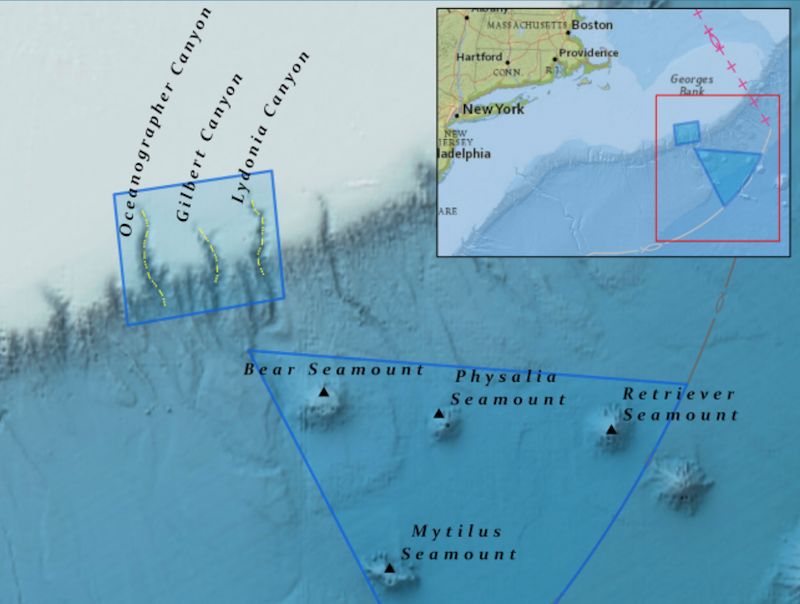A draft management plan lays out proposed rules for the Northeast Canyons and Seamounts Marine National Monument, on the eve of Friday’s deadline for commercial lobster and crab fishing in the nearly 5,000-square mile block south of Georges Bank.
The draft plan caps years of struggle over the future of the region, long sought by ocean conservation and environmental groups as a marine preserve. Established by former president Barack Obama under the federal Antiquities Act, the monument encompasses an area of the Atlantic nearly the size of Connecticut, ranging south from the Oceanographer, Gilbert, and Lydonia canyons at the edge of the shelf 130 miles off Cape Cod to the Bear, Mytilus, Physalia, and Retriever seamounts, remnants of ancient volcanoes.
Monument advocates said the Obama proclamation was needed to protect threatened and endangered marine mammals in the waters, and complex habitat on bottom slopes including deep corals.
The Obama administration moved to phase out trap fishing for lobster and crab, over protests and court challenges from fishermen’s groups. In July 2020, then-president Donald Trump announced who was rescinding the planned final ban.
Within days of taking office in January 2021, President Joe Biden’s administration moved to restore all the planned restrictions, at the urging of conservation and environmental groups. Commercial fishing advocates asked the new administration to reconsider, to no avail.
“A commercial fishing ban serves no conservation benefit,” James Budi of the American Sword and Tuna Harvesters longliners’ group said then. Officials of the National Oceanic and Atmospheric Administration had acknowledged that “pelagic longline gear used to catch swordfish has no impact on habitat,” said Budi. “Fishing impact on the monument below us is like a bird flying over the Grand Canyon.”
The end to lobster and crab gear is final as of Friday. The U.S. Fish and Wildlife Service draft plan outlines a host of other management measures, and other restrictions on commercial fishing activities.
Commercial fishing vessels transiting the monument waters must do so with all gear stowed “without interruption,” the document notes, “and any recreational fishing, educational trips, research or photography, and fishing activities that involve commercial fishing are prohibited.”
For recreational fishing in the monument – now conducted mostly on pelagic tunas and swordfish – NOAA and USFWS “do not propose to require any permits beyond hose currently required by NOAA Fisheries in order to recreationally fish in the Monument.”
The plan document notes how public commentary on the plan has included calls for banning recreational fishing if commercial harvests are not allowed. But the Biden monument proclamation specifically ended commercial fishing there, it says.
“The proposed plan includes agency management roles and responsibilities, and lays out the goals, objectives and management activities needed over the next 15 years to provide proper care for the Monument’s unique ecosystem and natural resources, with a focus on research, education and community engagement,” according to a summary issued Sept 12 by NOAA. “The draft plan also includes an environmental assessment to evaluate the potential impacts of implementing the proposed management actions.”
“President Biden’s reaffirmation of the need to develop a management plan for the Northeast Canyons and Seamounts Marine National Monument further solidifies his commitment to protecting our most vital waters and the marine life that thrives in it,” said Janet Coit, NOAA’s assistant administrator for fisheries.
Later this year NOAA Fisheries will start rulemaking to incorporate the Monument boundaries and commercial fishing prohibition into the Magnuson-Stevens Fishery Conservation and Management Act regulations
The draft management plan, environmental assessment and planning updates can be found on the Monument management planning website. The public can submit written comments on the priorities and objectives described in the Monument’s proposed management plan and environmental assessment through Oct. 26, 2023 via the Federal eRulemaking Portal or by mail to: Northeast Canyons and Seamounts Marine National Monument, USFWS, 300 Westgate Center Drive, Hadley, MA 01035.
Following the 45-day public comment period, the U.S. Fish and Wildlife Service and NOAA will consider comments and determine if a revision to the draft plan is necessary. The management plan and environmental assessment is expected to be finalized in early 2024.







